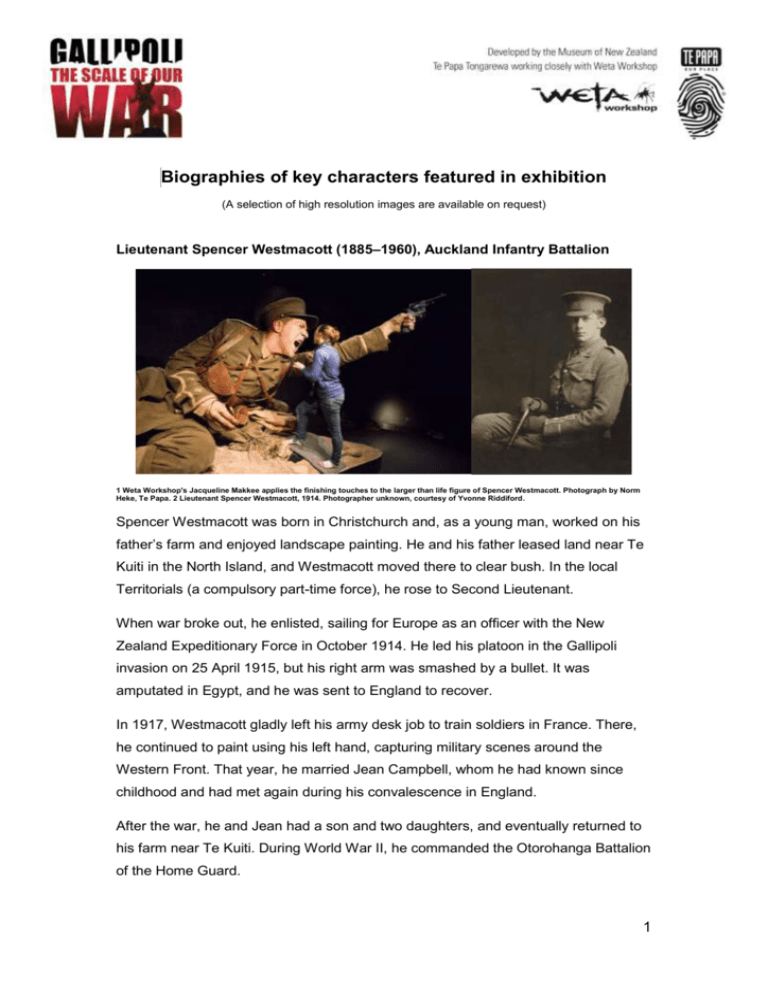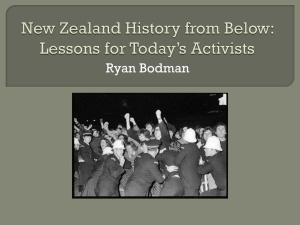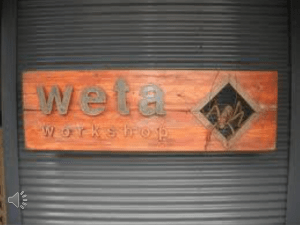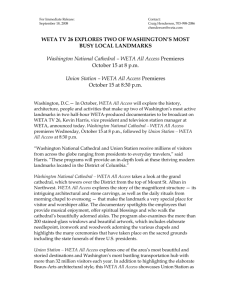Biographies of key characters featured in exhibition
advertisement

Biographies of key characters featured in exhibition (A selection of high resolution images are available on request) Lieutenant Spencer Westmacott (1885–1960), Auckland Infantry Battalion 1 Weta Workshop's Jacqueline Makkee applies the finishing touches to the larger than life figure of Spencer Westmacott. Photograph by Norm Heke, Te Papa. 2 Lieutenant Spencer Westmacott, 1914. Photographer unknown, courtesy of Yvonne Riddiford. Spencer Westmacott was born in Christchurch and, as a young man, worked on his father’s farm and enjoyed landscape painting. He and his father leased land near Te Kuiti in the North Island, and Westmacott moved there to clear bush. In the local Territorials (a compulsory part-time force), he rose to Second Lieutenant. When war broke out, he enlisted, sailing for Europe as an officer with the New Zealand Expeditionary Force in October 1914. He led his platoon in the Gallipoli invasion on 25 April 1915, but his right arm was smashed by a bullet. It was amputated in Egypt, and he was sent to England to recover. In 1917, Westmacott gladly left his army desk job to train soldiers in France. There, he continued to paint using his left hand, capturing military scenes around the Western Front. That year, he married Jean Campbell, whom he had known since childhood and had met again during his convalescence in England. After the war, he and Jean had a son and two daughters, and eventually returned to his farm near Te Kuiti. During World War II, he commanded the Otorohanga Battalion of the Home Guard. 1 Lieutenant Colonel Percival Fenwick (1870–1958), New Zealand Medical Corps 3 Weta Workshop's Marly Doyle applies the finishing touches to the larger than life figure of Percival Fenwick. Photograph by Norm Heke, Te Papa. 4 Lieutenant Colonel Percival Fenwick, about 1914. Photographer unknown, Courtesy of Philippa Horn and Richard Fenwick. English-born surgeon Percival Fenwick qualified in London and practised in Wanganui and Christchurch between 1895 and 1943. He married Nona Wright in 1903, and they had a daughter (Gwendolen) in 1905 and a son (Christopher) in 1908. Fenwick had been a military surgeon in the South African War (Boer War), and was quick to sign up when war in Europe began in 1914. He was among the first New Zealanders to land on Gallipoli on 25 April 1915. Throughout that day and night, he treated hundreds of wounded Anzacs on the beach, describing the scene as ‘hellish’. Fenwick was evacuated from Gallipoli, ill and exhausted, after two months. But he was soon commanding New Zealand military hospitals in England. In 1916, he received a CMG (Order of St Michael and St George) for his wartime services. He returned to New Zealand in 1919, a keen supporter of Anzac Day. At Christchurch Hospital in the 1920s, he pioneered the use of radium and radiotherapy. Fenwick repeatedly offered his services to the country during World War II, but these were refused, as his medical work was deemed too valuable. 2 Private John Robert Dunn (1888–1915), Wellington Infantry Battalion 5 Jack Dunn before 1915. Photographer unknown, Wairarapa Archive (05-39P-J-34_2. R14B9S4). 6 Weta Workshop's Richard Taylor applies the finishing touches to the larger than life figure of Jack Dunn. Photograph by Norm heke, Te Papa. ‘Jack’ Dunn was a journalist in Masterton and aged 25 when he enlisted with his brother Matthew in August 1914. He served in the Wellington Infantry Battalion under Lieutenant Colonel William Malone. He landed on Gallipoli with the battalion on 25 April 1915 and served there until July, when he was evacuated with pneumonia. He returned to duty still unwell and, on 18 July, was found asleep at his post, court martialled, and sentenced to death. The sentence was later commuted to imprisonment. A few days after he returned to duty, he was killed in the attack on Chunuk Bair. His remains have never been found. A comrade, Norman Miller, described Dunn as ‘being game to the core … He was all through the hardest of the fighting, and never flinched in the face of the most deadly fire to do his duty.’ 3 The Maori Contingent Machine Gun Unit – Warden, Hawkins and Carkeek. Private Colin Airlie Warden (1890–1915), Auckland Infantry Battalion 7 Colin Warden, about 1914. Courtesy of Jennifer Pearson and the Perkins family. Figure 8 Weta Workshop's Joel Ahie applies the finishing touches to the large scale model of Colin Warden. Photograph by Michael Hall, Te Papa. Australian-born engineer Colin Warden was working in Suva, Fiji, when war broke out. From there he enlisted in the Samoa Advance Party, which was sent from New Zealand to occupy German Samoa. He was one of 10 men known as the ‘Fijian Contingent’, which captured several German flags and later presented them to the New Zealand Government. Warden joined the New Zealand Expeditionary Force, which landed on Gallipoli with the Auckland Infantry Battalion. His brother Aubrey Airlie was there too, serving in the Australian Imperial Force. Warden was a fearless soldier – a crack sniper and machine gunner, and a favourite scout of Captain Jesse Wallingford. On the night of 6 August 1915, and although only a private, he commanded a 16-man Maori Contingent machine-gun team just below Chunuk Bair. On 8 August, they came under heavy fire and Warden was killed. ‘I now learn that poor old Warden is shot in the heart and 9 out of 16 of the Maori were casualties,’ wrote Wallingford. ‘Bravest and best of scouts. Died fighting his gun.’ 4 Corporal Friday Patrick Hawkins (Ngāti Kahungunu) (1891–1968), Maori Contingent 9 Rank Patrick 'Friday' Hawkins, 1914-15. Photographer unknown. Auckland Libraries (Sir George Grey Special Collection, AWNS-19170322-4546) 10 Weta Workshop's Marly Doyle applies the finishing touches to the larger than life figure of Patrick ‘Friday’ Hawkins. Photograph by Norm Heke, Te Papa. Friday Hawkins was born in Hastings and worked as a carpenter prior to enlisting. His previous military experience included School Cadets and being part of the 9th Hawke’s Bay Mounted Rifles. Hawkins was part of the Maori Contingent machine-gun team on Rhododendron Ridge covering the advance on Chunuk Bair. The team lugged their rifles, a heavy machine gun, and 14 boxes of ammunition and rations up the steep ridge. When the corporal at the gun was shot dead, Hawkins took over as No. 1 gunner, but a bullet through the wrist fractured his forearm. The wound led to his discharge in 1916. After his discharge, Hawkins moved to Australia and lived in Canberra. He had a daughter, Noni Hawkins. When World War II broke out, he was back in New Zealand, in Wellington. He re-enlisted with the 28th Māori Battalion, embarking for war with the 5th Reinforcements and arriving in Egypt on 15 May 1941. Hawkins returned to New Zealand in 1942 and transferred to the Royal New Zealand Air Force. He underwent training at Dannevirke and Linton before returning to active duty in 1943. He died in Auckland in 1968. 5 Private Rikihana Carkeek (Ngāti Raukawa) (1890–1963), Maori Contingent 11 Weta Workshop's Alistair McDougal applies the finishing touches to the larger than life figure of Rikihana Carkeek. Photography by Norm Heke, Te Papa. 12 Corporal Carkeek, between March 1916 and July 1917. Carkeek Family Collection. Rikihana Carkeek was born in Ōtaki and educated at Te Aute College. He enlisted with the Maori Contingent and sailed with them to Anzac Cove. On 6 August 1915, he was part of Private Colin Warden’s machine-gun team covering the advance on Chunuk Bair. They held their position on Rhododendron Ridge, but it was exposed and dangerous. Warden was killed, then the first gunner, then Corporal Friday Hawkins was badly wounded. Carkeek took the gun, but was shot through the neck. He dragged himself down to the beach, where he was evacuated to a hospital ship. He returned to fight six weeks later. Carkeek survived the war, reaching the rank of Second Lieutenant. He returned home and married Pareraukawa Atkinson (Aunty Polly). They lived in Picton and Rangiotu while raising their family of 11 children. Carkeek also worked as a certified interpreter. He returned to Ōtaki in the late 1920s. 6 Staff Nurse Lottie (Charlotte) Le Gallais (1881–1956), New Zealand Army Nursing Service 13 Lottie Le Gallais, about 1913. Photographer unknown. Tāmaki Paenga Hira Auckland War Memorial Museum (PH-95-02). Figure 14 Weta Workshop's Richard Taylor applies the finishing touches to the large scale model of Lottie Le Gallais. Photograph by Michael Hall, Te Papa. Lottie Le Gallais was an Auckland nurse on the hospital ship Maheno. She’d joined up to be near her brother Leddra (Leddie), who’d also enlisted. She found out she’d been appointed to the Maheno only a few days before it sailed from Wellington in July 1915. She hoped to catch up with Leddie in Egypt, but by then he was on Gallipoli. In November, her letters to Leddie came back to her stamped: ‘Reported killed’. He’d been dead four months, but only family back home had received the news. Lottie returned to New Zealand on the Maheno, arriving in Auckland on New Year’s Day, 1916. She resumed work at Auckland Public Hospital while also caring for her widowed father, who was in his late 70s. Lottie married Charles Gardner eight months before the war ended. They had a daughter, Anne (1919), and a son, Charles (1921). In the 1930s, Lottie’s husband became the Mayor of New Lynn. Today, their descendants still occupy the couple’s West Auckland home. In 1995, Anne donated her mother’s World War I nursing papers to Auckland War Memorial Museum. 7 Sergeant Cecil Malthus (1890–1976), Canterbury Infantry Regiment 15 Private Cecil Malthus, 1914. Photographer unknown. Courtesy of the Malthus family. Figure 16 Weta Workshop's Sam Gao puts the finishing touches on the large scale model of Cecil Malthus. Photograph by Michael Hall, Te Papa. Cecil Malthus was born in Timaru and graduated with an MA in French and English from Canterbury College (now University) in 1912. He was teaching at Nelson College when war was declared in 1914. Malthus served in the Gallipoli campaign, spending several weeks at the dangerous position of Quinn’s Post. He was hospitalised three times with illnesses caused by the dire conditions. Redeployed to France with the New Zealand Division, Malthus was wounded on the Somme in September 1916, losing toes on his right foot to an exploding bomb. Invalided home, he married his long-time sweetheart Hazel Watters in 1918, and together they raised five children. Malthus returned to France on a two-year study scholarship in 1920. He taught at the University of Tasmania from 1923. In 1933, the University of New Zealand awarded him its first ever doctorate in literature. The family returned to Christchurch in 1934 when Malthus became Professor of Modern Languages at Canterbury University, where he worked until his retirement in 1956. Malthus wrote two vivid books about his war experiences. Anzac: A Retrospect (1965) was posthumously republished with the sister volume Armentières and the Somme in 2002. 8 Other biographies Captain Jesse Alfred Wallingford (1878–1944), Auckland Infantry Battalion Captain Jesse Wallingford, 1916 (detail). Photograph by Herman Schmidt. Auckland Libraries (Sir George Grey Special Collections, 31-W1263). Jesse Wallingford was born in England in 1878. His father was a sergeant in the Rifle Brigade in the British Army, and Wallingford joined up at age 13. He earned a reputation as a crack shot and became an instructor at the army’s Musketry School in 1894. He won rifle- and pistol-shooting competitions in Britain and Europe and was a member of the British shooting team at the 1908 Olympics. In 1911, Wallingford transferred to the New Zealand Defence Force as a machinegun expert. He left for active service as a captain with the Main Body in 1914. On Gallipoli, Wallingford’s exploits as a sniper and machine-gunner became legendary. He placed machine guns precisely where they would cause maximum losses to attacking Turkish infantry and often went out alone into no-man’s-land to stalk and shoot Turkish snipers. Wallingford’s ‘conspicuous bravery’ won him the Military Cross. His speed and accuracy with rifles earned him the nickname ‘The Mad Minute’. Health problems led to his return to New Zealand in 1916. He continued to serve in staff positions until 1927, when he was appointed superintendent of the Mt Roskill Veterans’ Home. He died in Auckland on 6 June 1944, aged 73. 9 Lieutenant Colonel William George Malone (1859–1915), Wellington Infantry Battalion Figure 17 William Malone, about 1912. Photograph by James McAllister. Alexander Turnbull Library (PAColl-10155-1-12) Born in England, William Malone emigrated to New Zealand in 1880. He’d been a keen Volunteer soldier in England and served briefly in the Armed Constabulary in Taranaki before training as a lawyer. He continued to serve as a Volunteer soldier in his spare time and, by 1914, he was not only a very prominent lawyer but also commanded the 11th (Taranaki Rifles) Regiment. He took his soldiering extremely seriously, and prepared himself for war by avid study of military theory and history. At the start of the war, Malone was given command of the Wellington Infantry Battalion. He was a strict and relentless trainer, demanding the highest standards of his men, but he also concerned himself with their health and welfare. On Gallipoli, he did much to improve the Anzac positions, especially the dangerous location of Quinn’s Post. His demands for better supplies and conditions on behalf of his men brought him trouble with his superiors. In contrast to his severe military persona, his letters to his wife and children reveal a loving and sensitive husband and father. In August 1915, Malone led his battalion in an assault on Chunuk Bair, fighting heroically until being killed by artillery fire from his own side. His body was never found, and his bones lie there today, along with those of 700 of his men. As a soldier who stood up for his men, Malone is remembered for his bravery and achievements. 10 Second Lieutenants Gordon and Robin Harper, Canterbury Mounted Rifles Figure 18 Trooper Robin Harper, Canterbury Yeomanry Cavarly, 1914 (detail). Photographer unknown. Courtesy of the Harper family. Figure 19 Lieutenant Gordon harper, Machine Gun Section, Canterbury Mounted Rifles, Gallipoli, late 1915 (detail). Photographer unknown. Courtesy of the Harper family. Brothers Gordon (1885–1916) and Robin (christened Robert Paul) (1887–1972) Harper belonged to the well-known Harper family of Canterbury. When the war started, they were farming at Waiau in North Canterbury and were members of the Canterbury Yeomanry Cavalry – a part-time Volunteer unit. Both brothers joined the machine-gun section of the Canterbury Mounted Rifles soon after the war started, and sailed with the Main Body to Egypt. They landed at Anzac Cove on 12 May 1915 and were involved in fierce fighting, especially the August attacks on Chunuk Bair and Hill 60. At Hill 60, the Canterbury unit captured a Turkish machine gun, which Robin immediately turned round and fired at enemy troops. The brothers’ bravery was rewarded: they were both awarded Distinguished Conduct Medals and commissioned as Second Lieutenants. The captured machine gun was sent to Christchurch as a trophy. It is still owned by the Harper family, who have lent it to Te Papa for display in Gallipoli: The scale of our war. The family has also lent another machine gun, a Maxim, for the exhibition. This gun was used by the Canterbury Mounted Rifles on Gallipoli and the Sinai Peninsula. Gordon was firing it when he was fatally wounded on 9 August 1916. The Maxim was sent home by Robin, who survived the war, and the family have kept it as a memorial to Gordon. 11







